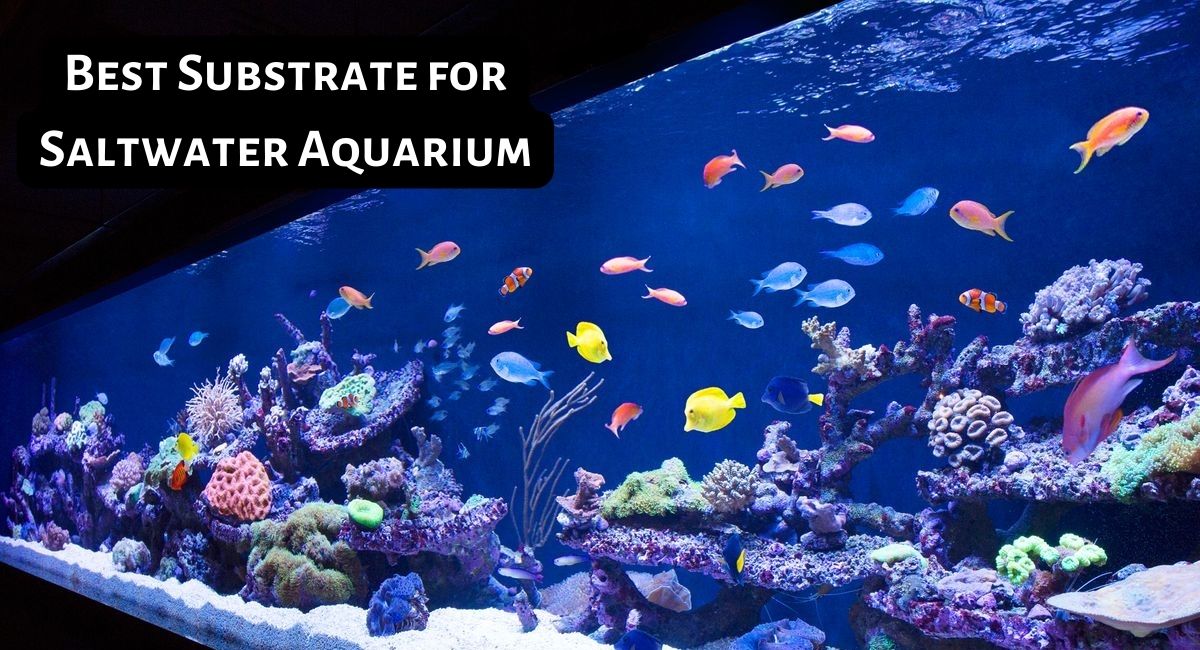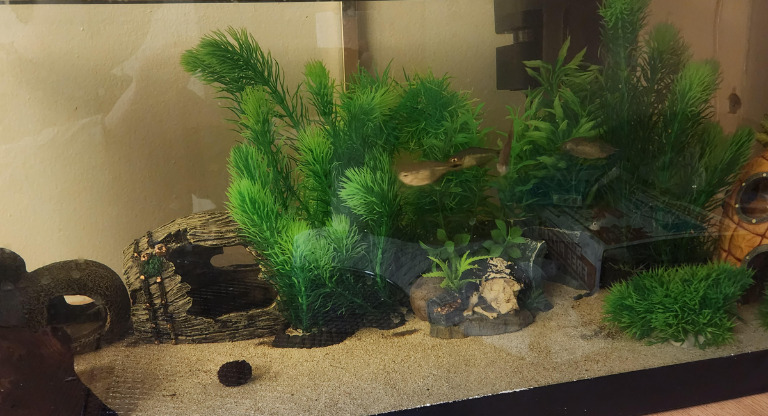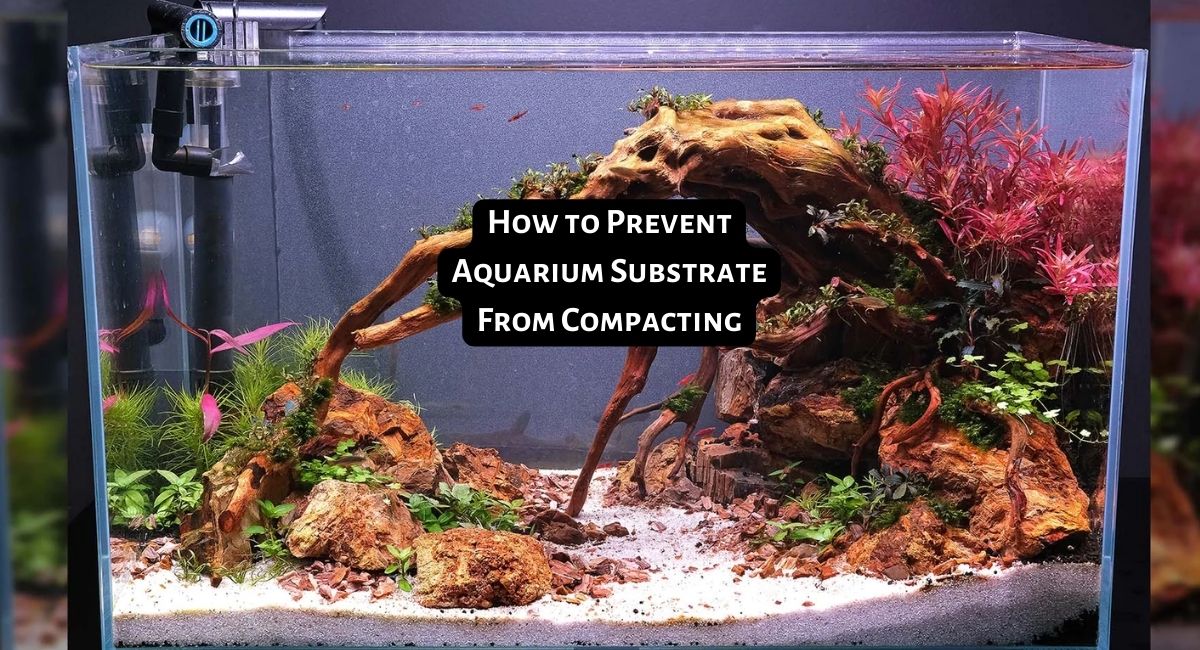Smartplantedaquarium.com participates in affiliate marketing programs. We may earn commissions on purchases made through our affiliate links. This doesn't affect our content or recommendations and we only recommend products we would put in our own tanks.
When it comes to setting up a saltwater aquarium, choosing the right substrate is essential. Not only does the substrate affect the water chemistry and the overall health of your tank environment, but it also plays an important role in creating a natural-looking habitat for your fish. With so many options available, it can be hard to choose which is the best substrate for saltwater aquarium. In this blog post, we’ll take a look at all the different substrates you can use, and cover which will give you the best results when setting up a saltwater tank.
We’ll also discuss what to consider before making a decision on which substrate is right for your tank. Hopefully by the end of this blog, you’ll have a better understanding of what the best substrate for your saltwater aquarium is. Let’s get started!
TL;DR
When setting up a saltwater aquarium, selecting the right substrate is essential for creating an environment that supports healthy fish and coral life. The best substrates include aragonite sand, crushed coral or fine gravel, all of which provide buffering capacity to stabilize pH levels and aid in maintaining proper mineral balance. Other substrates like crushed oyster shell, coral fragments, and even live rock can also be used to provide additional benefits. Ultimately, it is important to select the substrate type that best suits the aquarium inhabitants and provides a sustainable environment for them to flourish.
Contents
Best Substrate for Saltwater Aquarium
So, what are the different types of substrates available? Generally speaking, there are two categories: live sand and dry sand. Live sand contains beneficial bacteria and other microorganisms that help to keep the tank environment healthy and stable, while dry sand is just that – a substrate with nothing living in it. Both types of substrates have benefits and drawbacks, so let’s explore each one to find out what makes them unique.
What Creatures Do You Have in Your Aquarium?
When it comes to the best substrate for saltwater aquariums, there are many different types of substrates that can be used. Each type of substrate can provide specific benefits for the various types of fishes in your aquarium.
- For a reef tank, a fine aragonite sand is the best substrate to use. Aragonite sand is rich in calcium and other minerals which will help to buffer the water and create a healthy environment for your corals.
- For a fish-only tank, reef gravel or marine sand may be the best option. Reef gravel is slightly larger than aragonite sand and can provide more oxygen in the water. Marine sand is also larger than aragonite and can create an interesting environment for your fish to explore.
- For a large tank with many live plants, eco-complete or aquarium soil may be the best option. Eco-complete is designed to provide your plants with nutrients and promote healthy root growth. Aquarium soil consists of soil particles, clay, and other organic matter that helps to oxygenate the water and provide a natural environment for your live plants.
Ultimately, when choosing the best substrate for saltwater aquariums it’s important to consider what type of fish you have in your tank and how they need to be supported. Aragonite sand is best for reef tanks, while gravel or marine sand are better suited to fish-only tanks. For those with live plants, eco-complete or aquarium soil are the best options. With the right substrate in your tank, you can create a healthy and thriving environment for your fish and other aquatic creatures.
Are you looking to create a stunning aquarium that both you and your fish will love? Choosing the right substrate is key. Our guide on choosing the ideal substrate for your aquarium provides all the information you need to select the perfect substrate for your aquarium, from the different types of substrate available to how to set up your aquarium for success. Don’t miss out on this valuable resource!
Types of Saltwater Aquarium Substrates
No matter which substrate you choose, make sure it is compatible with your tank’s inhabitants and that you monitor water levels to ensure that your tank remains healthy and safe. With the right substrate, you can create a thriving saltwater aquarium that brings hours of enjoyment to you and your family.
- Live Sand: The most popular of saltwater aquarium substrates, live sand provides a natural biological filter and is home to beneficial bacteria that break down organic waste.
- Aragonite Sand: Aragonite sand is composed of crushed coral skeletons, which naturally adds essential minerals to your tank water. It also helps maintain pH levels.
- Crushed Coral: Crushed coral is made from the skeletons of small sea creatures and is similar to aragonite sand in terms of its ability to buffer pH levels and add beneficial minerals.
- Gravel: Gravel comes in a variety of sizes, colors and textures that can be used as an aquarium substrate for saltwater tanks. It can be used as a decorative base for plants, live coral and other aquarium decorations.
- Sea Grass: Sea grass is an organic substrate that contains beneficial bacteria which helps break down organic waste. It also provides shelter and hiding spots for fish and invertebrates.
- Substrates with Live Rock: Live rock substrates are composed of a mix of sand, crushed coral and pieces of live rock. This mixture provides beneficial nutrients for your tank inhabitants and promotes healthy water chemistry.
- Clay Substrates: Clay substrates are composed of natural minerals that help buffer pH levels and provide essential trace elements to the tank’s water system. They also help keep aquarium gravel stirred up, which helps prevent anaerobic bacteria from forming.
- Organic Substrates: Organic substrates are composed of natural materials such as peat moss, leaf litter and other organic matter. These provide beneficial bacteria that help break down organic waste and add trace elements to the tank’s water system.
- Synthetic Substrates: Synthetic substrates are made of synthetic materials such as colored gravel or plastic beads. These can be used to create a unique look in the aquarium, but they don’t provide any other benefits.
Types of Aquarium Sand
Out of the ones we have mentioned above, live sand is easily one of the better options available in the market. They not only have a natural feel to them, but they are also highly easy to maintain.
- Live sand is often the preferred choice when setting up a saltwater aquarium because it has natural bacteria colonies that help to maintain the tank’s water quality and pH balance. It also encourages beneficial bacteria growth, which helps to keep the tank clean and free from algae. The downside of live sand is that it can contain parasites or other contaminants if not properly cleaned before being used in a saltwater aquarium.
- Dry sand, on the other hand, is free from any microorganisms or other contaminants and is usually the most affordable option when it comes to substrates. It also helps to maintain a stable tank environment, however its main drawback is that it doesn’t contain any beneficial bacteria colonies, so you’ll have to introduce them yourself.
Whether you’re a seasoned aquarium enthusiast or a beginner, choosing the right substrate for your planted aquarium is essential for success. With so many options on the market, it can be overwhelming to know where to start. That’s why we’ve created a detailed guide to help you find the best substrate for planted fish tank. It covers everything from substrate types to composition, and even includes product recommendations to make your selection process even easier.
How Much Substrate Would You Need for a Saltwater Aquarium?
When setting up a saltwater aquarium, one of the most important components you need to consider is the substrate. Substrate is the material used to line the bottom of an aquarium and serves multiple purposes. It not only adds visual appeal to your tank, but it also acts as a biological filter, houses beneficial bacteria, and provides space for organisms like live rock and plants to attach to.
Factors to consider when choosing the right substrate
When choosing the right substrate for your saltwater tank, there are few factors you should consider:
- Type of substrate: There are many different types available, such as sand, crushed coral, gravel, and each comes with its own set of benefits and drawbacks.
- Amount of substrate: You’ll need to decide how much substrate you’ll require for your tank. This will depend on the size of your aquarium and the type of substrate you have chosen. Generally, a depth of two to three inches is recommended for most saltwater aquariums; however, if you are using live rock or certain types of sand, you may require more.
Maintenance of substrate
Once you have determined the amount of substrate required for your tank, it is important to ensure that it is properly maintained. This includes:
- Regularly testing the water parameters
- Cleaning the substrate when needed
- Replacing live rock or certain types of sand every few months in order to keep your tank healthy.
Sand vs Crushed Coral – Which is Better?
If you are looking to set up an aquarium for saltwater fish, one of the most important decisions you will have to make is what type of substrate to use. While there are many options available, two of the most popular choices are sand and crushed coral. Each has its own benefits and drawbacks, so it’s worth taking a closer look at each in order to determine which is best for your aquarium.
Sand
Sand has several benefits, including:
- Lightweight and won’t damage glass bottom tanks
- Provides a functional habitat for beneficial bacteria and organisms in the tank
- Great hiding place and surface for burrowing for fish and invertebrates
- Relatively easy to clean
Crushed Coral
Crushed coral also has its advantages, including:
- Durable and won’t break down easily
- Suitable for tanks with heavier fish or invertebrates
- Helps to buffer water and maintain a higher pH level
- Aesthetically pleasing
Choosing the Right Substrate
Ultimately, the choice between sand and crushed coral comes down to personal preference and the needs of your specific tank. Crushed coral may be the way to go if you want a durable substrate that will help buffer the water. On the other hand, if you prefer something that is less expensive and easier to clean, sand might be the better option.
No matter which substrate you choose, regular maintenance is crucial to keep your aquarium healthy and beautiful. Keep a close eye on water parameters, regularly test the water, and clean the substrate to prevent the buildup of debris and detritus. With proper care and maintenance, your saltwater aquarium can thrive for years to come.
Conclusion
Choosing the best substrate for your saltwater aquarium is crucial for the health and well-being of your aquatic pets. There are many options available, from sand to crushed coral, and each has its own unique benefits and drawbacks. Ultimately, the decision should be based on your specific needs and preferences as an aquarist.
Some factors to consider include the type of saltwater creatures you plan to keep, the pH level of your water, and the overall aesthetic you wish to achieve in your tank. Remember to thoroughly research each substrate option and consult with fellow aquarists and professionals before making a final decision.
With the right substrate in place, your saltwater aquarium will thrive and provide a beautiful and fascinating display for years to come.
When it comes to creating a thriving freshwater aquarium, the right substrate is essential. Luckily, we’ve done the research for you and put together a guide on the best substrate for freshwater fish tank that covers everything you need to know. With our expert advice and detailed reviews, you can make an informed decision and give your fish the best possible environment.
Frequently Asked Questions (FAQs)
1. What kind of substrate is best for saltwater aquarium?
Gravel is the most popular substrate for saltwater aquariums because it provides good aeration, allows beneficial bacteria to colonize, and offers plenty of hiding places for fish and other aquatic life. However, some aquarists prefer to use more natural materials such as sand or crushed coral. Sand offers more of a natural look and helps create a healthy environment for nitrifying bacteria, while crushed coral can help buffer the water and raise the pH levels, which can be beneficial for some species of fish.
2. Is sand or gravel better for saltwater aquarium?
Choosing the best substrate for a saltwater aquarium is largely dependent on personal preference and the type of fish or invertebrates being kept. Sand tends to be more natural-looking while gravel can provide a better environment for beneficial bacteria. In general, sand is better for smaller fish and bottom feeders because it allows them to filter food more easily. Gravel can be better for larger fish as it provides more support so they don’t sink into the substrate. Ultimately, it is important to research the type of fish and invertebrates you are keeping in order to determine which substrate would best suit their needs. In some cases, a combination of both sand and gravel may be the best option.
3. What is the best bottom for saltwater aquarium?
The best substrate for saltwater aquariums is aragonite sand. Aragonite sand provides a buffer to maintain the correct pH and alkalinity levels, as well as providing essential trace elements for coral growth. This type of sand also helps to reduce nitrate and phosphate levels, helping to keep your tank healthy. It’s also aesthetically pleasing, and can help create a natural-looking environment for your fish and other marine life. If you’re looking to create a thriving saltwater aquarium, aragonite sand is an excellent choice.






